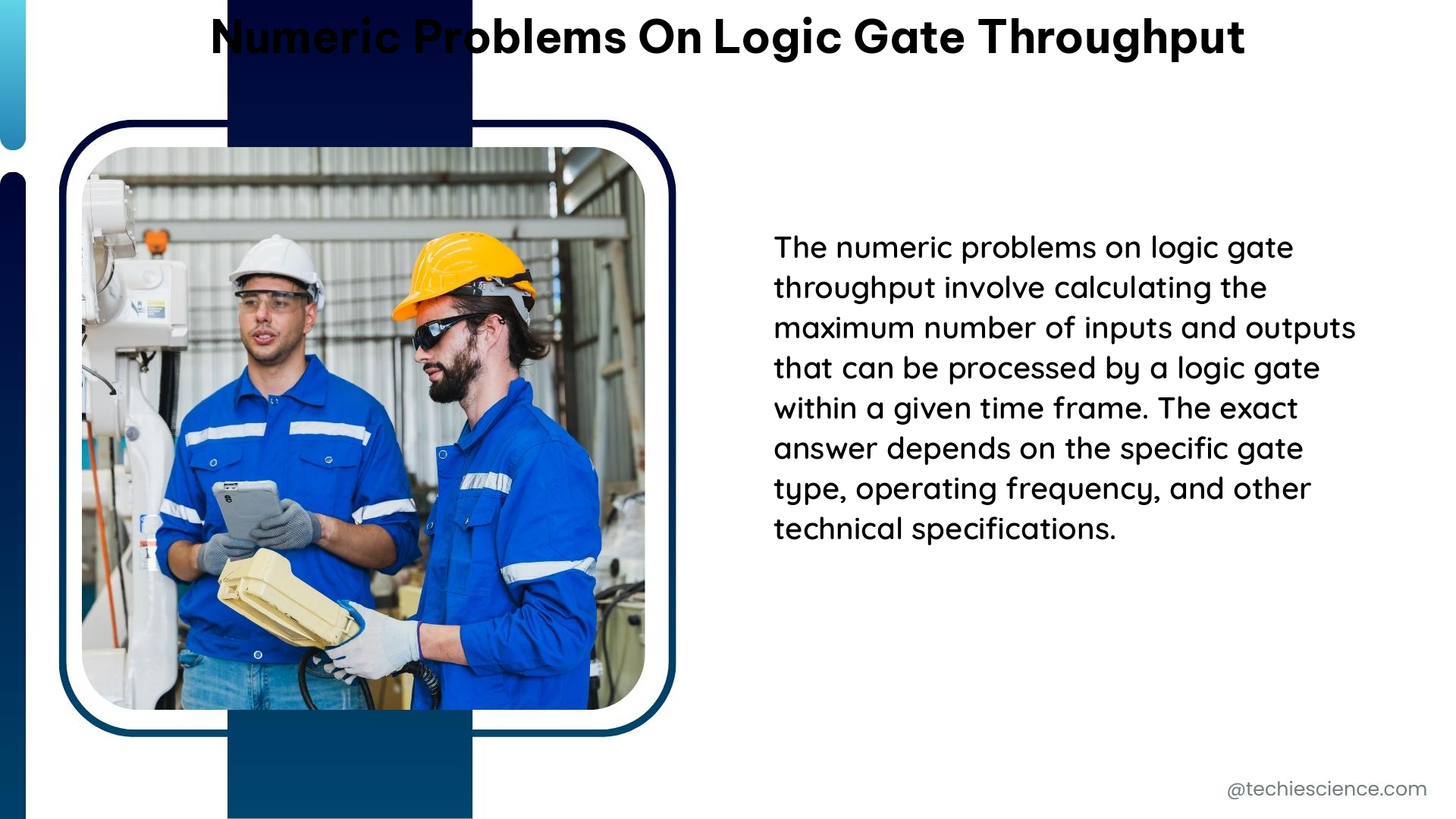Navigating the intricate world of digital electronics and computing requires a deep understanding of logic gate throughput, a crucial metric that directly impacts the speed and efficiency of information processing. In this comprehensive guide, we will delve into the theoretical background, formulas, examples, and numerical problems related to logic gate throughput, equipping you with the knowledge and tools to tackle these challenges with confidence.
Theoretical Foundations of Logic Gate Throughput
Logic gates are the fundamental building blocks of digital circuits, responsible for performing basic logical operations such as AND, OR, NOT, NAND, NOR, XOR, and XNOR. The throughput of a logic gate can be defined as the number of logical operations it can perform per second, and this metric is determined by the gate’s propagation delay.
Propagation delay (td) is the time it takes for the output of a logic gate to change in response to a change in the input. This delay can be calculated using the following formula:
td = tLH + tHL
where:
– tLH is the time it takes for the output to change from low to high
– tHL is the time it takes for the output to change from high to low
The throughput (TP) of a logic gate can then be calculated using the following formula:
TP = 1 / td
where:
– TP is the throughput in operations per second (OPS)
– td is the propagation delay in seconds (s)
By understanding these fundamental relationships, we can dive deeper into the analysis and optimization of logic gate throughput.
Calculating Logic Gate Throughput: Examples and Numerical Problems

Example: Throughput of an AND Gate
Consider an AND gate with a propagation delay of 10 nanoseconds (ns). The throughput of this gate can be calculated as follows:
TP = 1 / (10 × 10^-9)
TP ≈ 100,000,000 OPS
This means that the AND gate can perform approximately 100 million logical operations per second.
Numeric Problem: Throughput of a Digital Circuit
Suppose you have a digital circuit consisting of 100 AND gates, 100 OR gates, and 100 NOT gates, all with a propagation delay of 10 ns. Calculate the total throughput of the circuit.
Solution:
First, let’s calculate the throughput of each gate type separately:
TP(AND) = 1 / (10 × 10^-9)
TP(AND) ≈ 100,000,000 OPS
TP(OR) = 1 / (10 × 10^-9)
TP(OR) ≈ 100,000,000 OPS
TP(NOT) = 1 / (10 × 10^-9)
TP(NOT) ≈ 100,000,000 OPS
Since all gates have the same propagation delay, the total throughput of the circuit can be calculated as follows:
TP(Total) = TP(AND) + TP(OR) + TP(NOT)
TP(Total) = 100,000,000 + 100,000,000 + 100,000,000
TP(Total) = 300,000,000 OPS
Therefore, the total throughput of the circuit is 300,000,000 operations per second.
Advanced Considerations and Optimization Techniques
While the formulas and examples provided above offer a solid foundation for understanding logic gate throughput, there are several advanced considerations and optimization techniques that can further enhance the performance of digital circuits.
Factors Affecting Logic Gate Throughput
- Propagation Delay Variation: The propagation delay of logic gates can vary due to factors such as temperature, voltage, and manufacturing process variations. Accounting for these variations is crucial for accurate throughput calculations.
- Fanout and Load Capacitance: The number of gates connected to the output of a logic gate (fanout) and the capacitance of these connections (load capacitance) can significantly impact the propagation delay and, consequently, the throughput.
- Interconnect Delay: The delay introduced by the physical interconnections between logic gates can also contribute to the overall propagation delay and affect the throughput.
Optimization Techniques
- Gate Sizing: Adjusting the size of logic gates can help balance the trade-off between propagation delay and power consumption, optimizing the overall throughput.
- Pipelining: Dividing a digital circuit into multiple stages, with each stage performing a specific task, can increase the throughput by allowing multiple operations to be executed concurrently.
- Parallelism: Implementing multiple instances of the same logic gates or circuits in parallel can significantly boost the overall throughput, at the cost of increased area and power consumption.
- Advanced Circuit Design Techniques: Techniques such as dynamic logic, domino logic, and pass-transistor logic can offer improved throughput performance compared to traditional static CMOS logic.
By understanding these advanced considerations and optimization techniques, you can further refine your approach to numeric problems on logic gate throughput, ensuring the highest possible performance in your digital systems.
Conclusion
In this comprehensive guide, we have explored the theoretical foundations, formulas, examples, and numerical problems related to logic gate throughput, a crucial metric in the world of digital electronics and computing. By mastering these concepts, you can now tackle complex numeric problems with confidence, optimizing the speed and efficiency of your digital circuits.
Remember, the journey of understanding logic gate throughput is an ongoing process, and there are always new advancements and techniques to explore. Stay curious, keep learning, and continue to push the boundaries of what’s possible in the realm of digital electronics.
References
- A computational paradigm for dynamic logic-gates in neuronal activity
- Deep Differentiable Logic Gate Networks – OpenReview
- How to measure network performance metrics
- How to find out if a binary number is zero or not using logic gates?
- Top 15 Help Desk Metrics to Measure IT Support Performance

The lambdageeks.com Core SME Team is a group of experienced subject matter experts from diverse scientific and technical fields including Physics, Chemistry, Technology,Electronics & Electrical Engineering, Automotive, Mechanical Engineering. Our team collaborates to create high-quality, well-researched articles on a wide range of science and technology topics for the lambdageeks.com website.
All Our Senior SME are having more than 7 Years of experience in the respective fields . They are either Working Industry Professionals or assocaited With different Universities. Refer Our Authors Page to get to know About our Core SMEs.